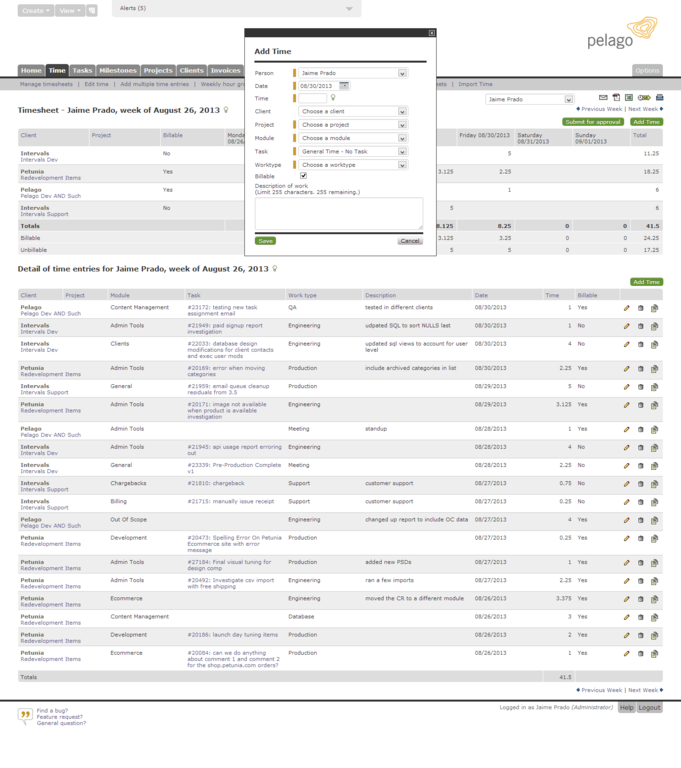![5 Great WordPress Themes for Dog Trainers Websites]()
by Kat Camplin | Aug 24, 2015 | Business

You’ve realized your website needs an upgrade and have decided to use WordPress to build it. One of the cool things about WordPress is you get to start with a template. Templates are basically a design framework that allow you to plug your own photos and text into and you end up with a snazzy site. Some templates come with plugins built in and some templates integrate with plugins better than others. Before purchasing a template, make sure it’s going to integrate with what you want to do.
We’ve put together the best options for paid and free templates. Why pay for a template? The paid options below come with technical support. If you’re new to WordPress and aren’t quite sure you can get started alone, paid options with support are a nice medium between full DIY and paying someone to build a site for you.
Our Favorite WordPress Themes for Dog Trainers

Image via Organized Themes
Organized Themes has a full range of templates available for your site. While some of them are designs for restaurants or stores with huge photos to showcase products, templates designed for non-profits are awesome, especially if you are a non-profit. Rescue organizations and humane societies can use the “Donate Now” button on the front page for fundraising efforts. If you’re not a non-profit, use the large action button for “Register today!”
All Non-Profit Themes, but we specifically like the Forward theme.
Support is delivered by a growing Knowledge Base and Support Forums. All questions in the forums are answered by the developer himself. Since he doesn’t have a full support team, customer support does have specific hours: Monday to Friday, 8:30 am to 5 pm, Central Standard Time GMT -5.
Pricing for these templates are based on either a single theme or period of access to all themes. A single theme with lifetime support and no monthly fee is $59. If you want to try out a bunch of themes before you settle on one, choose the 6 month membership for $89. This gives you access to all the templates as well as support for 6 months. If you don’t need support after the 6 months is up no further payment is needed.
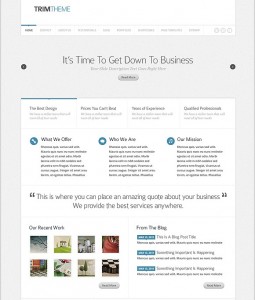
Image via Elegant Themes
Elegant Themes has 87 templates, which can make decisions difficult! Since Google now drops your search placement if your website is not Mobile friendly, stick to browsing the Responsive templates. We like the clean look of the Trim template. Remember, if the template has huge photos you will need to fill those spaces with your own graphics. For many of trainers that could be a problem.
Support is delivered by Documentation, step by step guide for template installation, and Support Forums. All questions in the forums are answered by Elegant technical support.
Pricing is an annual membership fee that gives you access to all 87 templates. The best option is $69 for a year. Once you’re all set up you can cancel your subscription and keep your final website for life.
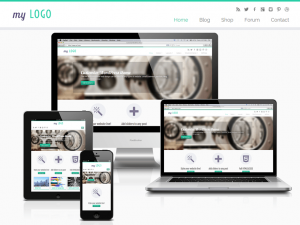
Image via WordPress
If you’re ready to go full DIY, you can download the free version of Cuztomizr, or get the Pro version, which includes access to Premium Support.
Customizr lives up to its name. It’s fully customizable with the Live Preview option, so you see your changes “live,” but unpublished. Checkboxes toggle front page items on and off, the color picker means you get to choose the exact color you want, and you get to use your own logo. This template supports most plugins and is fully responsive for mobile users.
Free Support is available through the official WordPress Customizer forum. Questions will be answered by either SuperUsers or the developer, but Super Users are more common. Start with the Documentation, some of your questions may be answered there. Paid Support is available from the developer though a Support Forum using an activation key. Questions are answered by “WordPress Experts,” which means carefully chosen Super Users and not necessarily the developer. Paid support is $44.95 per year.

Image via WordPress
i-transform is template with smaller spaces for photos, which means you don’t need to come up with huge, splashy graphics on the home page. It’s Mobile friendly and comes with a toolkit plugin for customization. While the finished theme looks awesome, this is very much a DIY project that will require you to read the documentation on the theme and the toolkit plugin that comes bundled with it to make the initial setup easier.
Free Support is available through the official WordPress i-transform forum. Questions will be answered by either SuperUsers or the developer, but Super Users are more common. Start with the i-transform Tutorial available from the developer. Some of your questions may be answered there.

Image via WordPress
Hueman is one of the more complicated templates due to the variability of sliding menus, headers and footers, and widgets. If you offer a lot of services, have multiple locations, or a lot of staff, utilize the three column front page so visitors can find what they need easily. This template is a very difficult DIY project, so you’ll need familiarity with WordPress and templates and some coding.
Free Support is available through the developer’s Documentation, and the official WordPress Hueman forum. Questions will be answered by either SuperUsers or the developer, but Super Users are more common.
Recommended Article: 5 Must Have WordPress Plugins for Dog Trainers Websites
Get Dog Training Business Tips!
Receive valuable dog training business tips and resources every week! Subscribe to The Modern Dog Trainer now by submitting your name and email below.
[mc4wp_form]
![5 Great WordPress Themes for Dog Trainers Websites]()
by Ines | Aug 10, 2015 | Business

As small business owners, we’re always looking to acquire new dog training clients. Discounts are a popular option that we think you’d better avoid.
1. Dog Training Clients Who Compare Prices Are Not The Right Clients For You
In reality, clients who are looking for the cheapest trainer in town are not looking for the most qualified and skilled dog trainer. You’re better off focusing your energy trying to get clients who will value your time and qualifications. If you’re looking to give back to the community, limit your free or discounted lessons to one or two lessons a week for those in need, but don’t make it the norm for all your clients. Consider creating a scholarship program for those that need your help, but cannot afford it immediately. This will weed out people who are just looking for a quick bargain and you’ll find some truly dedicated clients who simply can’t afford your usual price.
2. It Is Very Hard To Wean Customers Off Discounts
Once they’ve had a taste of your services at a discount, it can be difficult for clients to adjust to higher prices. They may continue to ask for discounts for one reason or another. This conflict could drain your energy and it may damage the relationship between you two.
3. Cutting Your Own Profit Margins
When we give discounts as dog trainers and small business owners, we’re emptying our own pockets. Discounts cut the profit margins and they devalue the product or service a client purchases. Unfortunately, the client is less likely to follow through with training plans and are less likely to sign up for full-priced services in the future.
Fortunately, there are hundreds of alternative ways to attract new clients.
The Best Alternative To Discounts
There is a simple alternative to offering discounts for your services. Consider providing add-ons for “free” so that the client perceives that they are getting a better deal by getting additional products or services. This way you can maintain your desired income and they are getting a great deal. It’s a win-win for both sides of the client-trainer relationship.
What are some ways you attract new clients? Leave your ideas in the comments below!
Get Dog Training Business Tips!
Receive valuable dog training business tips and resources every week! Subscribe to The Modern Dog Trainer now by submitting your name and email below.
[mc4wp_form]
![5 Great WordPress Themes for Dog Trainers Websites]()
by Kat Camplin | Jun 29, 2015 | Business

You may have missed the social media explosion resulting from a blog post by a well certified dog trainer admitting she passes off her pet dog as a Service Dog. At first glance this may not seem like a big deal. After all, the dog is well-behaved and giving a good representation of what a “well-trained Service Dog” looks and acts like. That’s not so bad, right? In fact, now that she’s come clean with her fakery, wouldn’t it be a good idea to allow all well-behaved dogs in public places? Should there be limits to where regular pet dogs can go if they’re well-trained? Maybe there should be a Pet Dog Access ID that could be earned that would allow dogs to go places. While the sentiment to allow our dogs in more public spaces is sound, the method she used is incredibly disturbing.
Before we go any further, let’s clarify some of what she admitted to.
- Telling taxi drivers her dog is a Service Dog so they would be allowed in a cab.
- Police were called when a cab driver denied her and her dog a ride.
- Having a friend create a fake Service Dog ID.
- Using the fake Service Dog ID when questioned by shop owners if the dog was a Service Dog.
While most of us can agree that going to such lengths as to call the police to perpetuate a lie is going too far, where do we actually draw the line of pushing our dogs into no-access spaces? As an example, let’s say it’s 105 degrees outside, your perfect dog is in the car, and your father was just rushed to the Emergency Room. Would you claim your dog was a Service Dog to be able to wait in the hospital lobby ? Would you push to be able go into the ER with your dog? Would it actually harm anyone if you did it? Or is harm only done if you get caught?
What is a service dog?
Service animals are defined as dogs that are individually trained to do work or perform tasks for people with disabilities.
What is a disability?
An individual with a disability is defined by the ADA as a person who has a physical or mental impairment that substantially limits one or more major life activities, a person who has a history or record of such an impairment, or a person who is perceived by others as having such an impairment. The ADA does not specifically name all of the impairments that are covered.
Let’s cut to the chase. If you don’t have a disability you do not have a Service Dog. Period. If your dog isn’t trained to do a specific task that mitigates your disability then your dog is not a Service Dog. Period.
To fake a Service Dog is illegal and insulting to people who rely on their dog to get through the day. How many daily conversations do people with disabilities need to have about their Service Dog just to get things done? We see articles all the time about businesses denying access to a person with disabilities with their dog. Just this week we saw a Purple Heart Recipient Denied Access. If you are a fake you are making it harder for people with legitimate need to get access.
In a time when we should be trying to educate businesses about what they can and can’t do, fakery only adds to the idea that everyone is faking it. A friend of mine owns a local deli which is visited by a woman with a completely unruly “Service Dog.” On the surface it would appear the dog is a fake. Aren’t Service Dogs supposed to be well-behaved? No, actually, they only need to be trained for a function. If the dog is unruly a business owner can ask them to leave. When I asked my friend why she didn’t ask her patron to leave she said, “I asked the health inspector since the dog is trying to get behind the deli counter. He said to just endure it. If I remove the woman and her dog there would be a huge backlash and I’d lose business.” Having businesses as allies is important. Why make this harder? If a business owner thinks they have no recourse if a Service Dog destroys something they’re not going to be accommodating. Trainers should be advocating for well-behaved Service Dogs and getting businesses on board, not trying to fool them.
One of the more interesting topics to come out of this social storm is what, if anything, the certifying bodies should do when one of their members makes an admission of guilt. Is a blog post enough to remove their certification? Is there a mechanism for a reprimand or probation or temporary removal of a certification? Or is it all or nothing? If we are positive reinforcement trainers advocating an ethical hierarchy to teach behavior in animals, aren’t humans animals? Do we have to go directly to +P? What is an appropriate response?
On the flip side, most of us have no idea how ethics investigations work with the certifying bodies we belong to. At least if you break a law you have some idea of the consequences. It would be beneficial to have an idea of the process of an investigation and the possible consequences, both as members and as witnesses to possible violations of standards.
As professionals, when you see another trainer presented with overwhelming evidence that they should reconsider their actions, what would you expect their reaction to be? This particular storm grew quickly because of the trainer’s gloating, defensiveness, attacking her critics, and further justifying her actions. She then took the offending blog post down and posted on her business page, “I am too busy training to argue with faceless people on the Internet.” An important lesson from this event: Once it’s on the internet you can’t get it back. Google cached it, people printed it, took screenshots of it, etc. It’s still out there. Her business page was barraged with comments. She simply could not remove them fast enough. As one popped up people replied and added more. It was The Perfect Weekend Social Storm.
Lesson: If you’re in over your head and taking attacks from all sides, step away from the computer and make a plan. As we all know, reactivity gets you into trouble every time.
For those of us who share this trainer’s certifications, we feel guilty by association. Is this what following a code of ethics looks like? Not to many of her fellow professional trainers. In this case a sincere public apology would be appropriate, both for the benefit of the profession as well as a demonstration to the Service Dog community that she understands how hurtful her actions were.
Since the blog post and firestorm happened on a weekend I’m sure there will be more to come from this story. We will post an update if more information becomes available.
![5 Great WordPress Themes for Dog Trainers Websites]()
by Kat Camplin | Jun 9, 2015 | Business

Image via Kat Camplin
For months I’ve been on a mission to find the perfect tool to track my time and my client’s time. Specifically, tracking prepaid package time for each client. On my list is a way to view package time use, alerts when payments are due, tracking prepaid money as credits, and easy invoicing. It should also be cost effective. $90 a month is out of the question. Most of my clients pay by check, so online payments aren’t a priority, but two of these systems support that function.
All of these services use a Client / Project format. The top-level is the Client and time tracking is at the Project level. This can take some getting used to if you’re not used to dealing with Projects. As an example, if you’re working for a rescue group tracking individual dogs as Projects is very handy. Each of the systems below has its pros and cons. Take a look!
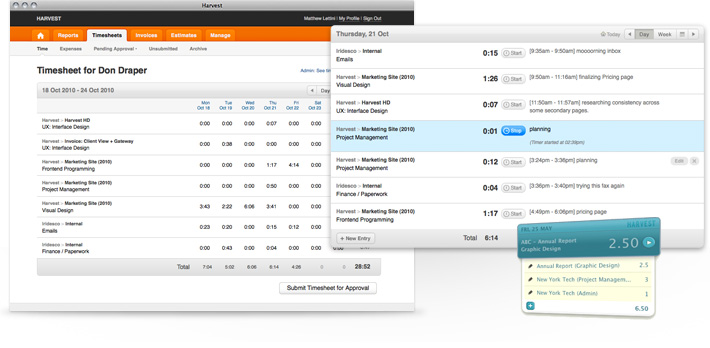
Image via Harvest
Website: https://www.getharvest.com/
Cost: 1 user – $12/mo. $10 for each additional user.
Free Trial?: Yes
With unlimited clients and projects for just $12 a month, Harvest tops the list for the solo trainer. Projects can be tracked via time or money, and the Project landing page has pretty blue sliders that show how much each Project has used and has left. You can set Project alerts based on percentage used, so you can remind your clients when there is only 1 or 2 sessions left early enough to tweak goals or talk about another package. If you charge for equipment or consumables you can add those in too.
The time tracking interface is friendly, giving you either a day view or week view to enter time against a Project. Click the day, choose the client and project, enter an hour amount and save. For the week view you can add lines for all your weekly clients and just tab across the days of the week entering your time. Putting this into your daily workflow will make this go even faster. Log your hours from the day before and stay ahead of the game. There is also an iPhone and Android app so you can log time on the go.
Invoicing is simple and you have a few choices. You can either base the invoice on previously logged hours, which pulls all your visits into single lines on the invoice, or you can do a free form invoice and fill in lines however you like. If you’re doing prepaid packages the free form invoice is a lifesaver. You fill in the cost per hour, number of hours and bam, invoice is done. Save the invoice and then you can immediately record a payment, which turns invoices into a nice receipt for your clients. You can either send clients a link to the invoice, download it as a pdf and send in an email, or print it out and send it snail mail.
You can accept online payments through Paypal Standard/Business or Stripe.
Harvest integrates with other online services on its own and through Zapier and IFTTT. If you use Quickbooks the integration is easy. To check out all integrations visit Harvest’s Integration page.
Website: http://www.freshbooks.com/
Cost: 5 clients – $10/mo. 25 clients – $20/mo. Unlimited – $30/mo.
Free Trial?: Yes
Freshbooks bases it’s cost on clients, not users. On the plus side if you’re doing a lot of rescue group work and need to track individual dogs as projects, the rescue group only counts as one client. However, if you have a large and revolving client base, archiving and un-archiving clients will be a pain. That said, I really like the idea of archiving inactive clients so you don’t have to scroll through people you don’t work with any more.
Time tracking is similar to Harvest, except you have the added option of a month view to enter time. You have the option to set hours as billed or unbilled as you log.
Freshbooks also has pretty blue sliders on the Project dashboard, but they are a little different. Instead of time used and left, the slider represents time against an estimate. You can use the Estimate time as your prepaid package time, so the slider will be a true representation of time used. The other columns show hours as billed or unbilled, which is handy if you’re tracking payment plans.
While I like how Freshbooks allows you to log prepaid credit, the credit is at the Client level, not the Project level. This means you are tracking time for the Project (dog,) but credit goes to Client (human or organization.) This can be a problem if you’re working with multiple dogs at a rescue group and invoicing is done separately per dog. You’ll have to remember which dog the credit goes towards.
Invoicing works basically the same as Harvest, you can choose between outstanding unbilled hours or enter information free form. Save the invoice and you can log a payment and send as a receipt by email or snail mail. There is no web link choice in this system.
The downside to Freshbooks is there isn’t an alert system as there is in Harvest. However, if you’re on top of your time and invoicing you really don’t need the reminders.
You can accept online payments either directly through Freshbooks or link to Paypal or Stripe. Freshbooks fees are 2.9% +.30 for Visa/MasterCard and 3.5% + .30 for American Express
There is a mobile app and lots of integrations with other systems, either directly or through Zapier. Check out the Freshbook Integration page.
Website: http://www.myintervals.com/
Cost: 15 Active Projects – $25/mo. 40 Active Projects – $49/mo.
Free Trial?: Yes
Intervals bases costs on Active Projects – not Clients or users. This can be a problem if you are handling more than 15 dogs at a time. However, Intervals adds Tasks functionality to time tracking and invoicing, which is appealing. Need to send an email or do a follow-up call for a specific Project? Intervals does that.
Document handling is also added, so if you want to keep contracts or liability waivers with your clients, you can do it all here.
Entering time isn’t quite as easy as on Harvest or Freshbooks, but you have more ways to track your work if you choose. With the addition of Modules, you can move Projects along a pipeline. As an example, you can set up Modules for Consultation, In-home training, Public DS/CC, Group Classes, etc., and watch the progress of the dog from one level to the next.
The thing that stands Intervals apart is how it handles prepaid time. The slider on the Projects dashboard is real, not an estimate. You enter payment credits and the cost per hour and you can see exactly how much is used.
You have free form and logged hours choices for invoicing, just like the other systems. If you’re invoicing for hours logged you have the easy option of choosing starting and end dates to bill. You can add payments to the invoice as you go, which saves you the step of having to save and invoice and then adding a payment afterward. Invoices can be sent via email, saved as pdf, or printed.
Integrations are limited and there isn’t a mobile app for logging on the go. Check out the Intervals Integration page.
Intervals does send a handy daily overview report of your business, time, and outstanding invoices.
Get Dog Training Business Tips!
Receive valuable dog training business tips and resources every week! Subscribe to The Modern Dog Trainer now by submitting your name and email below.
[mc4wp_form]
![5 Great WordPress Themes for Dog Trainers Websites]()
by Ines | Jun 2, 2015 | Business
Business cards should quickly show who you are, what services you provide, and legible contact information. You should include a phone number, an email address, and your website at the very least. Your brand should show clearly so that people have an idea of what they can expect from you. An outstanding business card can set you apart from other businesses in your area. The following dog training business cards go above and beyond the norm.
Dog Tag Mimic
The price tag tear off can easily be turned into a discount amount if someone sees your card and calls you for dog training help. The size and shape of this card can come in handy when determining where to leave it around town.
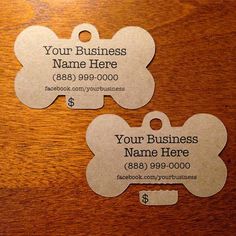
Kraftcuts
Oddly Shaped + Oddly Eye Catching
This cat tail business card idea can easily to altered into a dog’s tail to have the same effect. Its unusual size and shape can help you stand out, but might also cost a few extra dollars to produce.

Quick Sprout
Dog Behind Glass Card
This adorable card really captures your attention. It provides the viewer with a unique perspective while providing important contact information.

Design Crowd
Clicker Business Card
While most pet owners won’t know what the clicker is for, this can be a unique way to grab their attention. Accomplish two tasks at once with this clicker business info idea!

Pet Expertise
Fun + Durable
This kind of card is sure to stand out from the crowd. They are a bit more expensive, but they really make a statement.
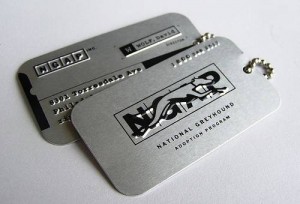
Plastic Card Online
Clean + Informative
This card provides all the necessary information with a clean and colorful design that is pleasing to the eye.
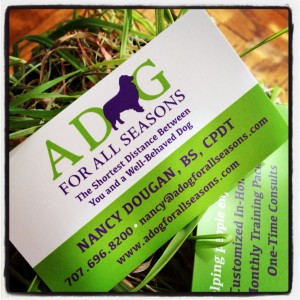
Chelsea McKenna
Modern + Professional
Potential customers know they are getting someone who values professionalism when they call the contact info on this card.
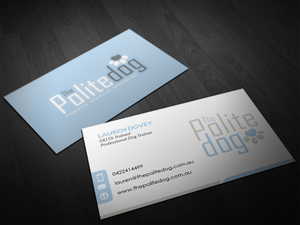
Design Crowd
Unique + Fun
While I don’t think most people would feed this one to their dog, they might pick it up to do so before they notice the information. This business “card” is a great way to get your information into someone’s hand.
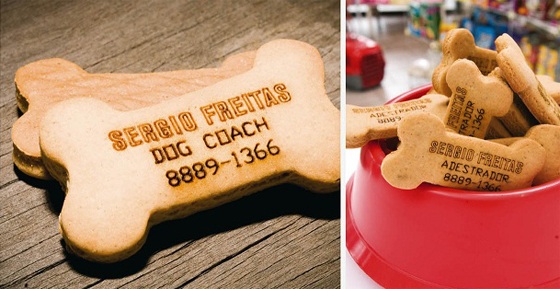
Personality + Eye Catching
This card shows a lot of personality and brings out good emotions in the person looking at it. It also makes the person curious about what it might be about.
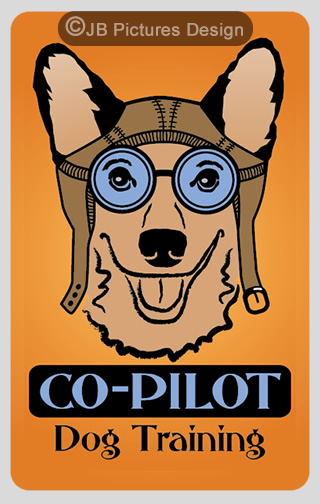
By JB Pictures
Folded Ears
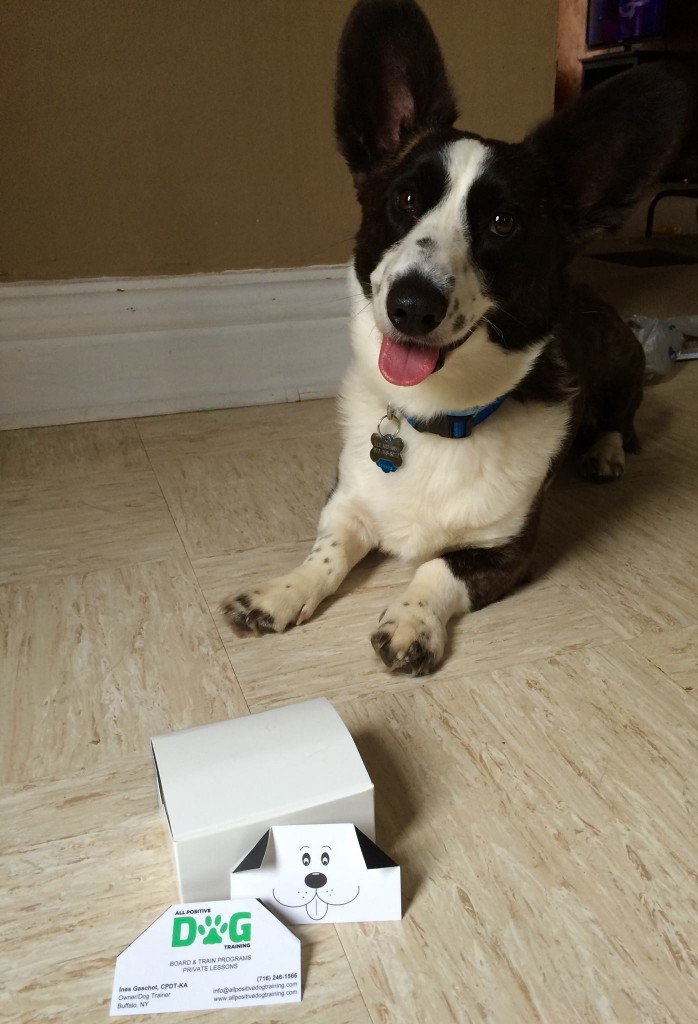

This is my personal business card that I made recently. It has received lots of positive feedback and I’ve already had one client mention that they saw my card at a local coffee shop. I’m offering the dog face and ears design for free to anyone who wants them on their business cards and you can click here and here to download them.
When you’re designing business cards, don’t be afraid to go for a 3D design. They don’t necessarily cost more if you cut or fold them yourself!
Get Dog Training Business Tips!
Receive valuable dog training business tips and resources every week! Subscribe to The Modern Dog Trainer now by submitting your name and email below.
[mc4wp_form]
![5 Great WordPress Themes for Dog Trainers Websites]()
by Erin Bessey | May 11, 2015 | Business
It can be daunting to coach others how to achieve a smooth transition for the dog in the house to a home with a baby, especially if you haven’t personally experienced it. It is more than encouraging the owner to bring home the baby blanket from the hospital for the dog to sniff.

image via Erin Bessey – Bessey’s Positive Paws
What Do You Cover?
As a trainer you already have more tools in your pocket to work with the parents than you might realize. When working with expectant parents that seek you out, often they are first time parents. They are being proactive in preparing their dog and home for the new addition. A lot of the preparation is looking to see where management will be effective, refreshing basic behaviors and dealing with the bad habits, understanding the level of exposure & socialization the dog has had to infants, babies & toddlers and recognizing stress signals in the dog and educating the owner about them.
Programs That Help
If you are a trainer that has had little experience with the different developmental stages of babies it is important to become familiar with them. There is a large difference between the infant and the baby that crawls. There are some excellent resources out there to help you as a trainer with this. Family Paws Parent Education has an abundance of information for parents and a program available to you as a trainer, Dogs & Storks, preparing families with dogs that are expecting a baby, and Dogs & Toddlers which prepares dogs for a life with a toddler.
Collene Pellar has a great book available called Living with Kids and Dogs. It is about managing kid and dog interactions from birth until young adults. This can apply to a family with a new baby in it or even the home that only has visiting children like nieces and nephews. She also has a book available specifically for people who work with dogs.
Management is Essential
Starting a dogs and babies program is all about setting the dog and family up for success, as is most of our training. Encourage them to think about how their lifestyle is going to change. It is important to impress upon them that the dog should have its own safe place away from the baby and the possible chaos. Bring back the crates, dog beds, or pens and refresh going to place. While children are a blessing and the baby becomes the number 1 in the family, it is important to remind them to advocate for the dog. The dog shouldn’t have to tolerate or be subjected to tail and ear tugs, being climbed over and having toys constantly snatched away from him.
It is rewarding to work with expectant parents especially during their pregnancy. They are being proactive and diligent about preparing their dog for the change. They will likely be some of your most compliant clients. Encourage them to expose their dog early to all the changes coming, the new equipment, noises, strollers and car seats. The programs can work as a group settings without the dog or as private sessions.
Get Dog Training Business Tips!
Receive valuable dog training business tips and resources every week! Subscribe to The Modern Dog Trainer now by submitting your name and email below.
[mc4wp_form]
![5 Great WordPress Themes for Dog Trainers Websites]()
by TMDT Team | Apr 20, 2015 | Business

All dog trainers want to build a healthy and successful dog training business. But as your dog training business grows, so does the stress of managing your expanding client list, schedule, and income stream.
The act of putting best practices in place to help you manage your growth sounds like both a daunting and tedious task. But the truth is it’s not. There are simple tips to follow and free technology available to make the act of building a successful and scalable training business a breeze.
Click the following link ON YOUR MOBILE device to sign up for this signature edition.
https://pocketsuite.io/register/modern-dog-trainer
Your Client List
To provide the quickest and highest quality service to prospective clients, you need to know who your client is, how to reach them, and what their needs are.
Keeping all this information in a single location will pay large dividends as your customer base grows. Mobile tools these days allow you to keep all your client contact information, notes, transaction history, and payment statuses in an easily accessible spot. Client data and access to information in the most convenient way possible will save you a tremendous amount of time, especially as your days start filling up with more and more client visits.
Schedule & Appointments
The days of pen and paper scheduling are over!
Keep an organized daily, weekly, and monthly calendar in place that’s easily accessible and able to be updated on the fly. Appointment details constantly change, so give yourself a digital tool that allows for easy edits and updates. Not to mention, new clients reach out to you at random times throughout the course of the day, so put convenient systems in place to efficiently field these appointment requests and add them to your calendar without having to play phone tag.
Make sure your clients stay organized too. That means automating and customizing notifications and reminders sent to clients about upcoming classes, sessions, or private lessons. This will ensure your clients are always on the same page, and will ‘professionally and politely’ remind them of upcoming appointments with you, so you never experience a no-show again.
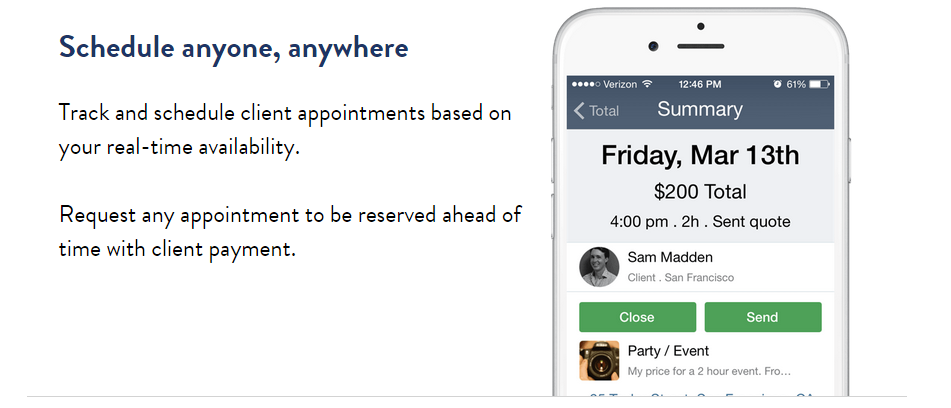
Payments
Everyone likes getting paid. The trick is to ensure that no payment ever slips through the cracks.
Protect yourself before walking into any training session. Ask clients to put their card down to reserve appointments ahead of time. This will not only reduce flaky clients and last-minute cancellations, but will professionally demonstrate to your clients that your time is valuable. Not mention, your entire payment process is streamlined once your appointment is complete – say farewell to those awkward “How much do I owe you?” conversations…Simply charge your clients as you’re walking out the door, and move on to your next appointment.
If you still prefer to invoice, then make sure no invoices are ever left hanging. Part of this is setting up a simple monitoring system to enable you to get notified with each invoice that has been paid. Then give yourself an easy dashboard to keep yourself up to date on any invoices still outstanding. This will also give you a sense as to who your best clients are (and even who your worst ones are).
Putting These Ideas Into Practice
 The question now becomes how to implement these tips in the easiest and least disruptive way possible.
The question now becomes how to implement these tips in the easiest and least disruptive way possible.
Good news! There are now tools out there that help solo professionals run their business from their phone. The key is to find the tools that are simple, that are affordable, and that move with you wherever you go – mobile. The more a single app does, the easier your life becomes.
As you start growing and winning more business, you’ll be able to bring these clients on in the most efficient way possible, maintaining your ability to serve them well – all the while making your day-to-day a lot less stressful.
Ready to be more efficient and professional with your clients?
Click the following link ON YOUR MOBILE device to sign up for this signature edition.
https://pocketsuite.io/register/modern-dog-trainer
About The Author
 Sam Madden is the co-founder of PocketSuite, the first mobile business tool for independent professionals and solopreneurs. Sam spent most of his career researching and investing in business technology for small and medium-sized businesses. He has since shifted all of his focus to build great technologies like PocketSuite to help eager and independent professionals succeed. You can read more about Sam’s mission on Entrepreneur Magazine.
Sam Madden is the co-founder of PocketSuite, the first mobile business tool for independent professionals and solopreneurs. Sam spent most of his career researching and investing in business technology for small and medium-sized businesses. He has since shifted all of his focus to build great technologies like PocketSuite to help eager and independent professionals succeed. You can read more about Sam’s mission on Entrepreneur Magazine.
PocketSuite is a new mobile app for dog trainers helping them run and build a better business. PocketSuite empowers pet professionals with the ability to schedule appointments, invoice customers, collect payment, track income, and communicate with clients…All from a single app.
Click the following link ON YOUR MOBILE device to sign up for this signature edition.
https://pocketsuite.io/register/modern-dog-trainer
![5 Great WordPress Themes for Dog Trainers Websites]()
by Monica Callahan | Apr 13, 2015 | Business

As a dog trainer, there are a lot of things we will need to take notes for, whether it is a new idea for a class or notes for each of our clients. Dog trainers can go through a lot of paper. A lot of modern dog trainers are now trying to go paperless in the new year, but still struggle with how to take their notes. Computers can be bulky, tablets can be expensive. Some trainers do not type well, but using a stylus on a tablet is not always accurate. What is a dog trainer supposed to do? Let me introduce you to the Boogie Board Sync 9.7.
The Boogie Board Sync is a 9.7″ ewriter that is less than 1/8″ thick. The screen is LCD that can be written on without power, however must be turned on to erase. The stylus is extremely accurate and is just like writing on paper. Now what makes the Boogie Board Sync 9.7 more than just a notepad?
The Boogie Board Sync 9.7 can be synced through Bluetooth to your phone or computer and the notes transferred instantly onto your computer or phone. Your pages can be saved into separate notebooks or they can be saved to your computer as a PDF. Pages can also be saved internally on the Boogie Board until you can transfer them to a computer or phone. Pages cannot, however, be brought back up on the e-writer once you have saved and erased them.

The Boogie Board Sync 9.7 has an erase button, a save button, an on/off button, and a place to store your stylus. The internal battery is charged through a mini USB port. A charge under normal use will last about five days.
Writing on the Boogie Board is like writing with a pen, you cannot erase certain marks as the erase button erases the whole page. This is something to keep in mind before you purchase a Boogie Board. The app for the Boogie Board has recently updated so you can edit a Boogie Board page through the app. You can also create shortcuts to automatically sort your Boogie Board pages to certain notebooks in the Sync app.

Some extra perks that people can utilize:
- Boogie Board has a real-time function with a phone or computer, allowing whatever you write on the Boogie Board to instantly show up on the phone or computer screen. This can be good for presentations or projects. You can still see the writing on the Boogie Board so you are not having to look at one screen while writing on another.
- Boogie Board can sync automatically to Evernote, which is a program growing in popularity with dog trainers.
- The Boogie Board can also sync with e-mail and social media almost instantly to share your notes.
Some issues that people may have a problem with include:
- The contrast of the screen. While I have not run into any issues with it, the screen is black and the writing is a green color. I could see this being an issue with someone who does not have good eye sight.
- Some people do not realize before they purchase a Boogie Board that you cannot erase certain parts of the screen, it is all or nothing.
- Some people do not realize before they purchase a Boogie Board that you cannot bring back a saved page on the actual Boogie Board, this would have to be done through the app.
The Boogie Board Sync 9.7 retails for around $80.99. The Boogie Board is available for purchase at local stores such as Best Buy, Costco, and Kohl’s, and also online at sites such as Amazon. If you’re interested in going paperless this year, but do not have the money to purchase an expensive tablet, the Boogie Board Sync 9.7 is a cost conscious alternative that you will not be disappointed in.
Get Dog Training Business Tips!
Receive valuable dog training business tips and resources every week! Subscribe to The Modern Dog Trainer now by submitting your name and email below.
[mc4wp_form]
![5 Great WordPress Themes for Dog Trainers Websites]()
by TMDT Team | Feb 18, 2015 | Business
Establishing a working relationship with a local veterinarian or clinic can be very lucrative. It can range anywhere from a small percentage of your total monthly or yearly clientele and income to one hundred percent of your entire business. One veterinarian, with whom I worked for many years, when asked what type of person she would look for in a dog trainer, had this to say:
“Someone who is a certified professional and shows me commitment, is experienced, and gentle and patient with animals. I’m more comfortable if I’ve seen them with animals personally. [They should be] willing to travel for in-home visits and handle owners well. You have to learn how to get the owners to be compliant, even if they are know-it-alls or stupid, all of which are very common.”
Before you go out to your local vet’s office and just try to introduce yourself, there are a few things that you should think about…
Write A Concise Introduction Letter
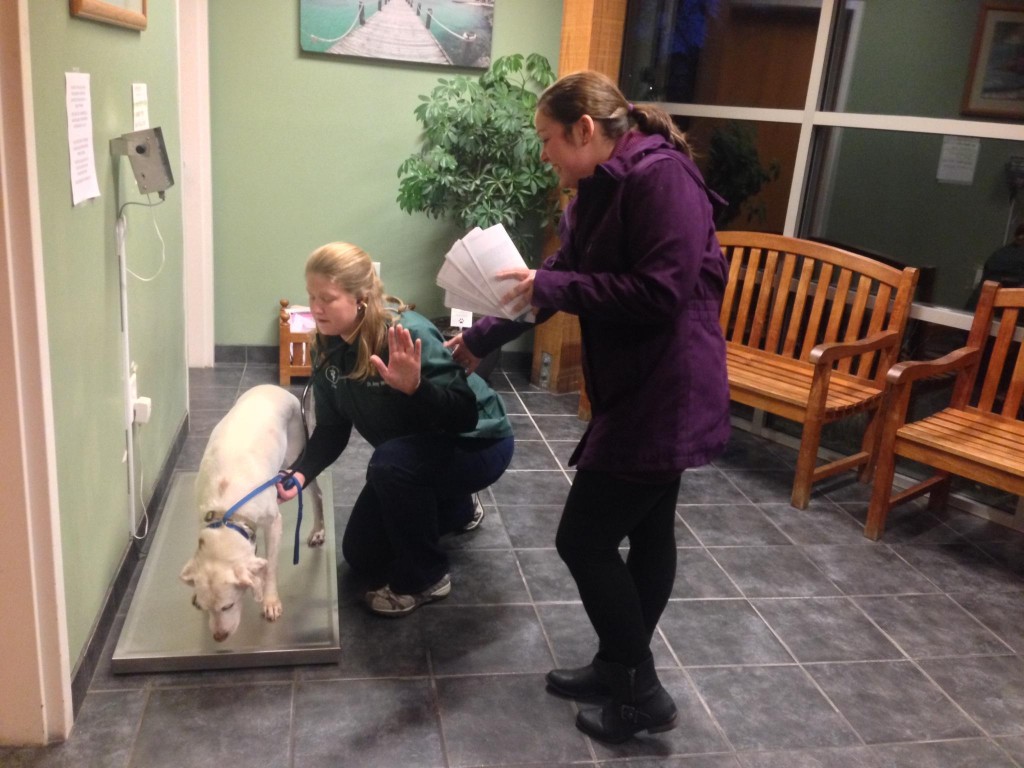
Writing a letter of introduction is probably the most effective way to start a relationship with a veterinarian. Veterinarians are generally very busy people! Visiting them during business hours without an appointment or invitation can be like having an off-leash dog interrupt your training session and start humping your client’s dog. Nobody wants to see that!
Writing a letter is the best opportunity you will have to tell them exactly what you have to offer and why they should choose to send their clients to you for training. Send letters to all the veterinarians in your area, addressed directly to the doctors themselves. Call them back and follow-up. Offer to bring in lunch or refreshments and discuss your services.
You might even offer to pay for an office call in order to compensate them for listening to you.
Know And Embrace Your Limitations!
Be clear and concise about both your strengths and your limitations. Remember, limitations are not shortcomings or weaknesses, but rather the limits within which you are comfortable or qualified to operate. You never want to misrepresent your abilities or qualifications. Being comfortable with your own limitations will help allow you to project a more professional attitude. It also keeps you out of trouble. You never want to accept an aggression case if you are not comfortable or qualified, the same way that you would never diagnosis a medical problem in a client’s dog. Build a strong network of other trainers and behavior consultants and know when to refer up the ladder.
Join Dog Training Trade Organizations
Two of the main organizations that veterinarians search to find dog trainers are The Association of Professional Dog Trainers (APDT) and The Certification Council for Professional Dog Trainers (CCPDT). Both of these organizations have trainer listings and searches that make it easy for you to be found. Other organizations, such as The Pet Professional Guild (PPG) and the International Association of Animal Behavior Consultants (IAABC) have the same types of listings and searches. However, overall recognition of these organizations by veterinarians seems in my experience to be very limited.
Acquire Professional Credentials
You will find that most veterinarians will take you more seriously if you are a certified professional. Achieving certification in dog training shows that you have made a serious commitment to your trade as well as to your own personal growth. The certification that veterinarians are most familiar with is Certified Professional Dog Trainer, either Knowledge Assessed (CPDT-KA) or Knowledge and Skills Assessed (CPDT-KSA). Both of these are available through the CCPDT, the only independent body that exists for certification in dog training.

Become Aware Of The Veterinary Trade Organizations
Spend some time, if you haven’t already, and become aware of some of the different veterinary trade organizations and their missions. The American Veterinary Medical Association (AVMA) and The Animal Hospital Association (AAHA) are two good examples. Membership in these organizations is voluntary and standards and guidelines are above and beyond those set by the rest of the industry. Being aware of which organizations a veterinarian is or is not a member of will help you to tailor your conversation, once you’ve started it.
Now that you know how to establish a relationship with your local veterinarian(s), who are you going to contact first?
Special thanks to Dr. Rebecca Simmons-Resnick for her input, Dr. Amy White, Ashley Ford, and Poppy for modeling for the photos, and Terri Dickinson for taking them!
About The Author
 John Stawicki is a force-free dog behavior trainer living in Cape Fear, NC, with his lovely wife Paige, and their seven assorted mutts. Together, they contemplate dogdom and their place in the universe. He may be reached at Cape Fear Positive Dog Training.
John Stawicki is a force-free dog behavior trainer living in Cape Fear, NC, with his lovely wife Paige, and their seven assorted mutts. Together, they contemplate dogdom and their place in the universe. He may be reached at Cape Fear Positive Dog Training.
Get Dog Training Business Tips!
Receive valuable dog training business tips and resources every week! Subscribe to The Modern Dog Trainer now by submitting your name and email below.
[mc4wp_form]
![5 Great WordPress Themes for Dog Trainers Websites]()
by Monica Callahan | Feb 17, 2015 | Business
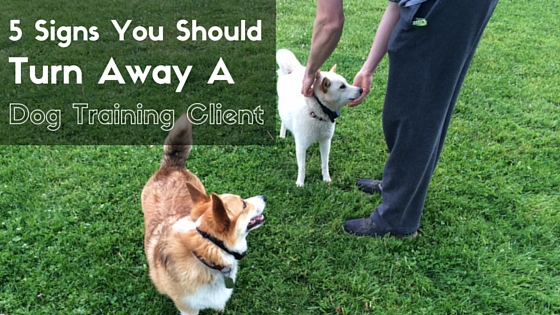
In nature, there are many personalities in humans that clash. Just like dogs, we do not get along with every person we meet. This does not mean that you or the other person are wrong, it just happens. As the dog trainer, we need to realize when our clients are not getting the most out of our training sessions. It is our responsibility to lead these clients to someone more suited to their needs and personality, who will give the client what they are paying for. There are many signs that indicate you should turn away a client, here are five of them.
1. You Dread Your Sessions
While we will not always enjoy every one of our sessions for various reasons, if you find yourself counting down the minutes until your session begins in agony and then counting down the minutes until it’s over, this may not be the right client for you. We cannot give our very best to someone when we start to resent or despise them, and this can occur when we dread our sessions due to the client. I would suggest evaluating your sessions and your client and finding out what makes you dread your upcoming sessions. If you find that you cannot handle your sessions anymore, it may be an option to turn away your client.
2. You Feel Your Client Is Absorbing Nothing You Are Teaching
While we all want to be paid to do nothing, sometimes it just doesn’t feel right to take money when your clients are gaining absolutely nothing from you. If you feel that you are trying to teach your client and they are just not picking up on what you’re saying no matter how you try to teach them, they may be better off trying someone else who has a different teaching style. Maybe your teaching and learning methods clash. If you feel your client is not gaining the knowledge on purpose, maybe because they don’t agree with your style, then this can also be a hint that you just aren’t the right teacher for them.
3. You Feel Offended By Your Client After Every Meeting
Is your client fighting every word that comes out of your mouth? Maybe they don’t agree with your methods and they make that loud and clear. Maybe they outright call you ignorant or feel that they know better than you do. Sometimes people are so set in their ways that they do not want to learn or they don’t realize what they are saying is coming off as offensive. After trying your best to communicate, sometimes it is just easier to agree to disagree and go your separate ways.
4. You Feel Unsafe Meeting Your Client Due To Location Or Emotional Feelings
Being a trainer who does private, in-home sessions usually means that you don’t know where you’re walking into. And sometimes there are some downright unsafe places. There are also people out there who can come across as very inappropriate or just give you an unsafe feeling. If you feel unsafe at all due to either reason, I would highly urge you to find a way to make yourself feel safe or just turn away the client. If bringing another trainer or assistant along would make you feel comfortable, I would highly urge you to do so. Sometimes I get an awkward feeling before we even meet and my husband and I set up a system so he knows where I will be and exactly when I arrive and leave. Safety is always a priority.
5. You Feel You Cannot Offer Your Client The Training They Need
There are a wide variety of needs clients want met. If you have never done agility and your client is looking for agility training, it may not be in your best interest to take on that client. Another reason may be that you don’t feel comfortable training certain things that your clients are looking for. In order to gain experience with new sports or methods, you may find a local trainer who excels at that particular method and ask to shadow or attend their lessons together so eventually you can also help clients looking at that particular sport or method.
Turning away a client is not a bad thing. It shows that you are responsible, honest, and know your boundaries. It also means that you are being safe about where you are and who you are with. These are all things that successful trainers are good at doing. What are some other reasons you may want to turn away a client?
Get Dog Training Business Tips!
Receive valuable dog training business tips and resources every week! Subscribe to The Modern Dog Trainer now by submitting your name and email below.
[mc4wp_form]











